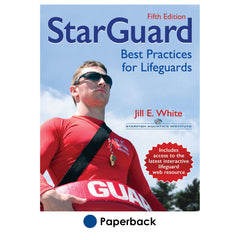Chest compressions
This is an excerpt from StarGuard 5th Edition With Web Resource by Starfish Aquatics Institute.
External compressions of the chest increases pressure inside the chest and directly compresses the heart, forcing blood to move from the chest to the lungs, brain, and the rest of the body. Creating and maintaining this pressure not only keeps vital organs alive but also increases the chances that defibrillation will be successful.
After chest compressions are started, it takes time to build up enough pressure to make blood flow. When chest compressions are stopped, the pressure and blood flow drop quickly. Thus, frequent interruption of chest compressions may contribute to poor survival rates. For that reason, minimize interruptions in chest compressions during CPR.
Adult or Child
- Position the person faceup on a flat, firm surface. Kneel close to the side of the person. You may find it helpful to raise the person's arm overhead to allow your knees to get in close to the body (a).
- Place the heel of one hand on the center of the chest, on the lower half of the breastbone. Place the heel of your other hand on top of the first. You can interlace your fingers to keep them off the chest. For a child, you may use one or two hands (b).
- Bring your body up and over the chest so your shoulders are directly above your hands. Straighten your arms and lock your elbows (c).
- Bending at the waist, use your body weight to push straight down to a depth of at least 2 inches (5 cm), but not much more. For a child, compress at least 1/3 the full depth of the chest.
- Lift your hands enough to release the pressure on the chest and allow it to recoil fully to its normal position. Do not lean on the person's chest.
- Without interruption, immediately move into the next compression. Continue compressions at a rate between 100 to 120 times per minute.
Quality matters! The better you compress, the greater the influence on survival. Focus on high-quality techniques. Avoid leaning on the person's chest between compressions.
Infant
- Position the infant faceup on a flat, firm surface. Place two fingertips on the breastbone just below the nipple line (a).
- Compress at least one-third the diameter of the chest, or about 1 1/2 inches (4 cm). Lift your fingers and allow the chest to recoil fully to its normal position. Without pausing, continue into the down stroke of the next compression. Without interruption, continue compressing at a rate between 100 to 120 times per minute. Keep up the force and speed of compressions, but be sure to allow the chest to fully recoil to its normal position between compressions.
- When two or more rescuers are present, compress the breastbone using two thumbs, with your fingers encircling the chest. This position allows for more effective compressions. The other rescuer will be providing rescue breaths (b).


Get the latest insights with regular newsletters, plus periodic product information and special insider offers.
JOIN NOW


